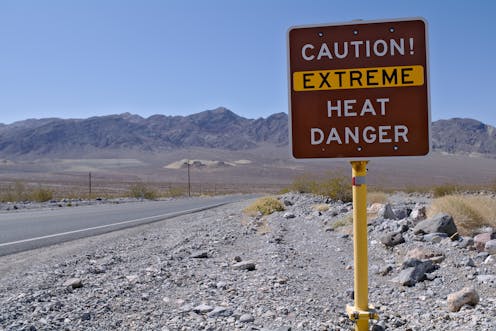Study finds 2 billion people will struggle to survive in a warming world – and these parts of Australia are most vulnerable
- Written by Annabelle Workman, Research Fellow, Melbourne Climate Futures and Melbourne School of Population and Global Health, The University of Melbourne

Two billion people, including many Australians, will find themselves living in dangerously hot places this century if global warming reaches 2.7℃, research[1] released today reveals.
The authors calculated how many people would be left outside the “human climate niche” by 2100. The niche is defined as places with an average temperature of about 13℃, or about 27℃ in the tropics. Human population has historically peaked in these areas.
The world is on track for 2.7℃ of warming[2] by 2100. This would push a third of people on Earth outside the human climate niche. This includes people in parts of northwest Australia such as Darwin, Broome and Port Hedland. It also includes parts of Southeast Asia, India, Africa and South America.
Limiting warming to 1.5℃ would substantially reduce the number of people exposed, including most of those affected in northwest Australia.
We were not involved in the research, which was conducted by researchers in the United Kingdom, China, Europe and United States. We are Australian experts in the health implications of global warming. Below, we discuss the broader implications of these globally significant findings.
What is the human cost of global warming?
The research calculated the number of people outside the “human climate niche” under different demographic scenarios and levels of warming. Exposure to unprecedented heat was the main factor pushing people out of the niche.
This includes an average temperature greater than or equal to 29℃, as well as a high number of days with a maximum temperature above 40℃ or in humid places, with a wet-bulb temperature[3] greater than 28℃. The wet-bulb temperature (as opposed to the standard dry-bulb temperature) reflects humidity and is a method used to measure heat stress. That’s because it’s the point at which sweating is no longer effective as a means of cooling.
The study says a wet-bulb temperature of 35 ℃ can be fatal, especially for vulnerable people, because the body can no longer cool itself.
Above the present level of about 1.2 ℃ global warming, the authors found exposure to unprecedented average temperatures increased markedly, along with increased exposure to temperature extremes.
But 2.7 ℃ of warming threatens a third of the world’s population. The below map shows where in the world people will suffer the worst heat. Almost the entire area of some countries, such as Burkina Faso and Mali in West Africa, would be exposed to unprecedented heat.
Developing healthier climate policies
Australian climate action targets have improved under the Albanese government, however they remain incompatible[27] with keeping warming to 1.5℃.
Approving additional coal projects[28] is not helpful for reducing emissions or demonstrating climate leadership.
A commitment to develop and implement a National Health and Climate Strategy[29] and establish a National Sustainability and Climate Unit are promising initiatives. This will help to address our woeful performance in a recent assessment[30] showing how national climate commitments don’t link with health.
Last week, the Victorian Government committed[31] to reducing emissions by 75-80% compared with 2005 levels by 2035. Their analysis indicates it will lead to A$5.7 billion in health benefits from improved air quality between 2035 and 2045.
As today’s new research states, the findings highlight the need for “more decisive policy action to limit the human costs and inequities of climate change”. Australia, in particular, must protect children, the elderly and the broader population from the harms they face in a warmer world.
Read more: Deadly heatwaves threaten to reverse India's progress on poverty and inequality – new research[32]
References
- ^ research (www.nature.com)
- ^ 2.7℃ of warming (climateactiontracker.org)
- ^ wet-bulb temperature (www.theguardian.com)
- ^ Source: Nature Sustainability (www.nature.com)
- ^ World Meteorological Organization (public.wmo.int)
- ^ Even incremental warming (www.who.int)
- ^ A 1.5℃ world (www.ipcc.ch)
- ^ 2019 study (link.springer.com)
- ^ underestimated (www.thelancet.com)
- ^ experts predict (www.science.org.au)
- ^ Here's why having chocolate can make you feel great or a bit sick – plus 4 tips for better eating (theconversation.com)
- ^ high-risk populations (www.ipcc.ch)
- ^ climate change creates and maintains health inequities (www.mja.com.au)
- ^ average surface temperature has warmed 1.2℃ (www.ipcc.ch)
- ^ economic costs of climate action (www.dcceew.gov.au)
- ^ economic costs of inaction (sustainable.unimelb.edu.au)
- ^ climate change can harm human health (www.ipcc.ch)
- ^ dehydration and heat stroke (www.who.int)
- ^ the elderly and those already unwell (www.mja.com.au)
- ^ increasing rates of injury and death (www.sciencedirect.com)
- ^ agricultural productivity, water security and air quality (www.science.org.au)
- ^ Australians are 3 times more worried about climate change than COVID. A mental health crisis is looming (theconversation.com)
- ^ particularly to heat (www.mdpi.com)
- ^ especially for outdoor workers (www.mdpi.com)
- ^ health service demand (bmchealthservres.biomedcentral.com)
- ^ Climate Action Tracker is an initiative of Climate Analytics and the NewClimate Institute (climateactiontracker.org)
- ^ incompatible (climateactiontracker.org)
- ^ Approving additional coal projects (theconversation.com)
- ^ National Health and Climate Strategy (www.health.gov.au)
- ^ recent assessment (climateandhealthalliance.org)
- ^ committed (www.climatechange.vic.gov.au)
- ^ Deadly heatwaves threaten to reverse India's progress on poverty and inequality – new research (theconversation.com)

















